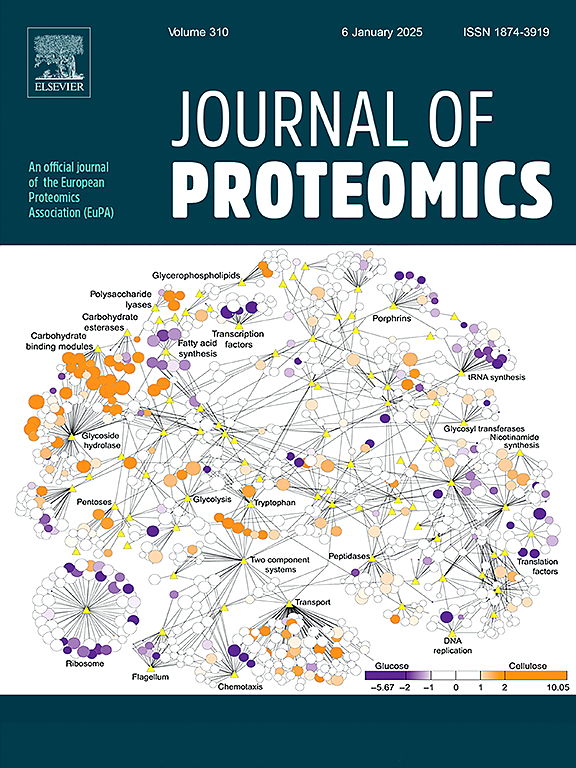Proteomic insights into cell signaling and stress response mechanisms in Chaetoceros muelleri under nitrogen limitation
IF 2.8
2区 生物学
Q2 BIOCHEMICAL RESEARCH METHODS
引用次数: 0
Abstract
Microalgae are often called “green factories” because they can perform photosynthesis, converting sunlight into biomass and high-value metabolites. Nitrogen concentration is a critical factor influencing protein accumulation. Unfortunately, nitrogen deprivation often negatively impacts biomass production. Understanding the relationship between nitrogen concentration and protein accumulation is crucial for harnessing the potential of microalgae in various industries and addressing environmental challenges. Here, we quantitatively compared the proteomic profiles of Chaetoceros muelleri diatom, grown in two Nitrogen-deficient conditions and control treatment by employing a Tandem Mass Tag-based quantitative proteomic approach. Proteins involved in photosynthesis were differentially accumulated under moderately nitrogen-deficient conditions. In contrast, proteins involved in cell signaling and protection mechanisms were differentially accumulated under severely nitrogen-limited conditions. Proteins associated with nitrogen metabolism, carbohydrate metabolism, and protein biosynthesis were differentially decreased in severely nitrogen-limited conditions, indicating differential response mechanisms of C. muelleri to varying nitrogen conditions. Our results show that C. muelleri employs distinct strategies in response to nitrogen limitation. These results provide valuable insights into the adaptive strategies of C. muelleri under nitrogen limitation, offering potential applications in optimizing microalgal cultures for the enhanced production of target metabolites in industrial bioreactors.
Biological significance
The marine diatom Chaetoceros muelleri accumulates lipids and carbohydrates under low nitrogen conditions without affecting its biomass. Response to nitrogen limitation in C. muelleri was examined by isobaric labelling-based proteomics. We identified changes mainly focused on photosynthesis pathways, cell signaling and protection mechanisms, nitrogen and carbohydrate metabolism, as well as protein biosynthesis. Our results indicate that C. muelleri activate unique strategies in response to different nitrogen concentrations, and this differential response represents a key factor for inducing metabolite accumulation without affecting biomass production.

氮限制下毛氏毛藻细胞信号传导和应激反应机制的蛋白质组学研究。
微藻通常被称为“绿色工厂”,因为它们可以进行光合作用,将阳光转化为生物质和高价值代谢物。氮浓度是影响蛋白质积累的关键因素。不幸的是,氮剥夺往往对生物质生产产生负面影响。了解氮浓度与蛋白质积累之间的关系对于利用微藻在各个行业的潜力和应对环境挑战至关重要。在这里,我们采用串联质量标签为基础的定量蛋白质组学方法,定量比较了生长在两种缺氮条件下和对照处理下的穆勒角毛藻硅藻的蛋白质组学特征。在中度缺氮条件下,参与光合作用的蛋白质积累差异较大。相反,在严重限氮条件下,参与细胞信号传导和保护机制的蛋白质积累不同。在严重氮限条件下,与氮代谢、碳水化合物代谢和蛋白质生物合成相关的蛋白质含量显著降低,表明木氏梭菌对不同氮条件的响应机制存在差异。结果表明,穆勒梭菌对氮素限制采取了不同的应对策略。这些结果为穆勒梭菌在氮限制下的适应策略提供了有价值的见解,为优化微藻培养以提高工业生物反应器中目标代谢物的产量提供了潜在的应用。生物学意义:海洋硅藻穆勒毛藻在低氮条件下积累脂质和碳水化合物而不影响其生物量。以等压标记为基础的蛋白质组学研究了穆勒梭菌对氮限制的响应。我们发现的变化主要集中在光合作用途径、细胞信号传导和保护机制、氮和碳水化合物代谢以及蛋白质生物合成。我们的研究结果表明,不同的氮浓度会激活不同的策略,而这种差异反应是诱导代谢物积累而不影响生物量生产的关键因素。
本文章由计算机程序翻译,如有差异,请以英文原文为准。
求助全文
约1分钟内获得全文
求助全文
来源期刊

Journal of proteomics
生物-生化研究方法
CiteScore
7.10
自引率
3.00%
发文量
227
审稿时长
73 days
期刊介绍:
Journal of Proteomics is aimed at protein scientists and analytical chemists in the field of proteomics, biomarker discovery, protein analytics, plant proteomics, microbial and animal proteomics, human studies, tissue imaging by mass spectrometry, non-conventional and non-model organism proteomics, and protein bioinformatics. The journal welcomes papers in new and upcoming areas such as metabolomics, genomics, systems biology, toxicogenomics, pharmacoproteomics.
Journal of Proteomics unifies both fundamental scientists and clinicians, and includes translational research. Suggestions for reviews, webinars and thematic issues are welcome.
 求助内容:
求助内容: 应助结果提醒方式:
应助结果提醒方式:


